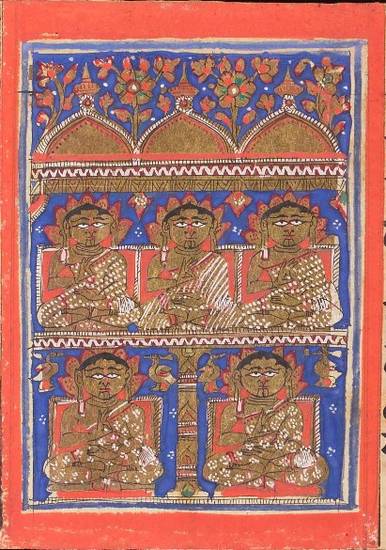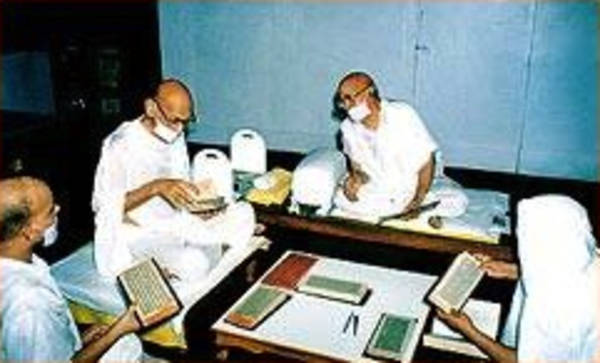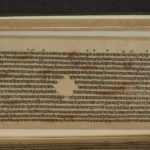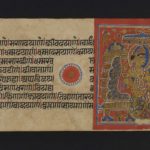Article: Śvetāmbara canon
Most religions have sets of holy writings that lay out key principles and offer guidance and examples to believers, and Jainism is no exception. For the Śvetāmbara sect, as for all Jains, the Jinas are the ultimate source of teaching. This is especially true of the 24th Jina, Mahāvīra. All Jains believe that this teaching was first transmitted orally. All sects also agree that this teaching was partly lost and partly changed over time. However, they disagree on which parts have vanished and which have been amended. This explains why the Śvetāmbaras and Digambaras consider different texts to be authoritative scriptures.
Śvetāmbara Jains have their own history about the transmission of scriptures and their own body of scriptures. The Śvetāmbara subsects disagree about what exactly these authoritative texts are. The number of accepted scriptures corresponds to a sectarian division which took shape from the 15th century onwards. Mūrti-pūjaks consider there are 45 scriptures while Sthānaka-vāsins and Terāpanthins state there are 32. Within the scriptures, some groups of texts are unchanging while others show fluidity and divergences.
Knowledge is significant for Jains because it is needed to make spiritual progress. The second type of knowledge in Jain epistemology is called ‘knowledge of what has been heard’ – śruta-jñāna – which means familiarity with the teachings of the Jinas. This is usually translated as knowing the scriptures, though there are long-running arguments over whether this alone is enough for spiritual development.
Whether they have access or not to the textual material passing on the Jinas’ teaching, all Jains are aware of the existence of their holy writings. These writings are the basis of their ritual and religious life and are venerated in various ways. The most striking examples are the Śvetāmbara festivals of Jñāna-pañcamī and Paryuṣaṇ, in which holy texts have central roles. Among contemporary Jains the scriptures remain key to religious life and cultural identity, leading to the development of new methods of sharing the teachings.
Terms
Using the English word ‘canon’ to describe Jain holy writings is increasingly thought unsuitable, because it suggests an unchanging body of texts sanctioned by a central authority. Śvetāmbara Jains commonly use the Sanskrit word āgama. This pan-Indian term emphasises the idea of a tradition that has ‘come down to us’ and which goes back to authoritative voices.
Other terms that are used are the Prakrit phrases ‘open teaching of monks’ – niggantha-pāvayaṇa – or ‘basket of the chief disciples’ – gaṇi-piḍaga. Used in the singular, these terms imply that the primary sources are of global relevance.
The term āgama largely suggests unfixed categories that may change, which more accurately describes the ‘Śvetāmbara canon’. Texts have been placed in the various classes of scriptures that have arisen. Some of these categories have changed with time, with texts moving from one to another, while others have remained more or less static, with stable content.
These groupings and therefore the number of texts that are recognised as Āgamas have become focal points for sectarian disagreements. The image-worshipping sect of Śvetāmbara Mūrti-pūjaks count 45 Āgamas while the Śvetāmbara Sthānaka-vāsins and Terāpanthins reject both this practice and 13 texts of the Śvetāmbara canon, which they consider apocryphal.
Groupings of texts
Though the Āgamas have been grouped in diverse ways over the centuries, these classifications may be compatible with each other because they are based on various criteria.
One of the early classifications distinguishes between:
- Aṅga-praviṣṭa – ‘included in the limbs’ or ‘main texts’
- Aṅga-bāhya or Aṅga-bāhira – ‘not limbs’.
It is clear that the Aṅgas form the core category. They are named and described in the Śvetāmbara scriptures themselves.
Another grouping correlates the texts with the time to study them. It makes use of the terms kālika and utkālika. In one source, the first term means that a text must be read at a specific time, although the meaning is unclear, and the second allows it to be read at any time. However, in another source it is the reverse.
There is also a fourfold classification relating to the subject matter:
- Prathamānuyoga – ‘First Exposition’
- Karaṇānuyoga – ‘Exposition on Calculations and Techniques’
- Caraṇānuyoga – ‘Exposition on Conduct’
- Kathānuyoga – ‘Exposition of Stories’
Although it is occasionally found in Śvetāmbara sources, this is more common among Digambaras.
The classification that has become largely predominant among the Śvetāmbaras, however, distinguishes five groups. Two additional texts are treated separately because they provide a methodological and ‘epistemological context’ (Dundas 2002: 76).
|
Sanskrit title |
Main categories |
Subcategories |
Approximate English meaning |
|---|---|---|---|
|
Pūrvas |
|
|
‘previous texts’ |
|
Aṅgas |
|
|
‘limbs’ or ‘main texts’ |
|
Aṅga-bāhyas: |
|
‘not limbs’ or ‘subsidiary canon’ |
|
|
Upāṅgas |
‘sub-Aṅgas’ |
||
|
Mūla-sūtras |
‘root texts’ |
||
|
‘rules for mendicants’ |
|||
|
Prakīrṇaka-sūtras |
‘miscellany’ |
||
|
Cūlikās: |
‘appendices’ |
||
|
|
|
Nandī-sūtra |
list of early teachers, discussion about kinds of knowledge, especially scriptural knowledge |
|
|
|
Anuyogadvāra-sūtra |
discussion of various topics regarding methodology |
On JAINpedia, as in many presentations of Jainism, this last grouping of the Śvetāmbara canon is followed.
Numbers of texts and sect
The texts that are identified as the Āgamas have become crucial mostly from the 15th century, as the number and labelling of texts contributes to sectarian identity. Śvetāmbara Mūrti-pūjaks recognise the authority of 45 texts while Śvetāmbara Sthānaka-vāsins and Terāpanthins accept 32 Āgamas.
Debates about this point show a distinction between an unchanging core, recognised by all Śvetāmbaras, and other categories. These latter are fluid classes.
|
Categories |
Texts |
Mūrti-pūjak texts |
Sthānaka-vāsin texts |
Terāpanthin texts |
|
|---|---|---|---|---|---|
|
Aṅgas |
yes |
yes |
yes |
||
|
Mūla-sūtras: |
|||||
|
Daśavaikālika-sūtra |
yes |
yes |
yes |
||
|
yes |
yes |
yes |
|||
|
Āvaśyaka |
yes |
yes |
yes |
||
|
Piṇḍa-niryukti and Ogha-niryukti |
yes |
no |
no |
||
|
Cheda-sūtras: |
|||||
|
Ācāradaśāḥ or Daśāśruta-skandha |
yes |
yes |
yes |
||
|
Bṛhatkalpa |
yes |
yes |
yes |
||
|
Vyavahāra |
yes |
yes |
yes |
||
|
Niśītha |
yes |
yes |
yes |
||
|
Mahā-niśītha |
yes |
no |
no |
||
|
Jīta-kalpa |
yes |
no |
no |
||
|
Pañca-kalpa |
yes |
no |
no |
||
|
Prakīrṇaka-sūtras |
yes |
no |
no |
Sthānaka-vāsins and Terāpanthins reject the whole of the last category – Prakīrṇaka-sūtras or ‘Miscellany’. With no fixed list of texts, it is the most fluid group, as recognised by authoritative scholar monks such as Muni Puṇyavijaya. The number of texts in this category ranges from 10 to 20, and there are also some called ‘supernumerary Prakīrṇakas’.
From the 17th century onwards there is copious evidence that the number of 45 Āgamas became emblematic of Śvetāmbara Mūrti-pūjak Jains. They were obviously keen on professing this as their position since they publicised this number by:
- writing lists of their Āgamas
- having manuscripts of the individual Āgamas copied, making collections of the 45 texts
- copying those texts that are specific to them – in contrast with other Śvetāmbaras – such as the controversial Mahā-niśītha-sūtra
- inventing visual modes to display the 45 Āgamas.
History of Śvetāmbara holy writings
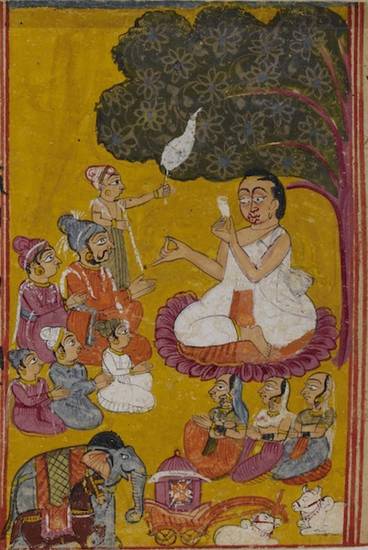
Indrabhūti Gautama preaches
Image by British Library © CC0 1.0 (Creative Commons Public Domain)
All Jains believe that the Jinas provide the original teachings for the Jain faith, especially Mahāvīra, the 24th Jina. The Jinas reveal the same essential truths, according to the needs of the society into which they are born. They pass on these principles in speech, beginning the chain of oral transmission. After being passed on for generations by leaders known as elders and teachers, these oral teachings are eventually written down, creating the scriptures.
The roots of the differences between the Śvetāmbara and Digambara canons can be traced to the physical split in the Jain community around 300 BCE. Large parts of the teachings had been forgotten already, such as the Pūrvas and the 12th Aṅga, the Dṛṣṭi-vāda, which both sects agree was lost by the 4th century BCE. The group of Jains who can be thought of as ancestors of the Śvetāmbara sect recognised that the famine that drove some Jains south endangered preservation of the tradition. They began to organise official recitations – vācanās – or ‘councils’ to consolidate knowledge of the teachings. The final council was held in Valabhī, Gujarat, under the supervision of the religious teacher Devarddhigaṇi Kṣamāśramaṇa in the 5th century CE. It took place ‘980 or 993 years’ after Mahāvīra’s death according to tradition, which is 453 or 466 CE. All the texts that are considered to comprise the Śvetāmbara canon were written down there. However, accounts of the event, which are all much later, do not provide names of the texts that were collected.
The Jains who later developed into the Digambara sect did not accept any of these councils. They believe that the remnants of the original teachings were written down in the 2nd century CE. These form the basis of the Digambara canon.
Marginal texts among the Śvetāmbara scriptures occasionally describe the inevitable deterioration of the teachings in the future. This will happen in the sixth descending phase of the cycle of time, in the reign of King Kalkin, when all principles of faith, knowledge and right conduct will be destroyed. The situation will be restored with the ascending cycle of time.
Dates of the texts
Establishing conclusive dates for the Āgamas is difficult for two main reasons, primarily connected with long intervals between the stages of the transmission process. Scholars can use internal features of the texts and surviving manuscripts to work out the probable dates of the texts in relation to each other.
The production process of the Śvetāmbara writings shows a very large gap between the time of oral transmission and the time when the Śvetāmbara tradition was officially fixed. Academic dating of Mahāvīra gives his lifespan from 497 to 425 BCE. The final redaction of the Āgamas took place in 456 or 466 CE. This gap of nearly a thousand years makes absolute dating of the texts impossible.
There is also a long time between the redaction and the period of the oldest available manuscripts. Some texts written on palm leaves survive but the earliest ones date back to the 11th to 12th centuries. This is some seven hundred years after the final Valabhī council.
Philologists have used internal criteria to come up with robust relative dates of the canonical texts. They compare features such as language, vocabulary, literary styles and material characteristics in many examples of the same text to roughly determine its relative age. Observations relating to the language used show that parts that may be remnants of the pre-Valabhī phases can be distinguished from other parts. Texts in which Ardhamāgadhī features prevail over Jaina Māhārāṣṭrī, such as the Ācārānga-sūtra, are considered ‘earlier’ works. Metrical form has been used as ‘an often trustworthy, if necessarily limited, guide to chronology’ (Dundas 2002: 73). It has been shown that there could be ‘earlier’ and ‘more recent’ parts in texts in which diverse metres – for example, rhythmical versus syllabic forms – used at different times are found side by side, for example the Mūla-sūtras.
Passing on the teachings

Monastic teacher and pupils
Image by Victoria and Albert Museum © V&A Images/Victoria and Albert Museum, London
In its most restricted understanding, the phrase ‘Śvetāmbara Āgamas’ refers to the sūtras. This is both a style of writing – short aphorisms – and a more general phrase meaning any sacred text. In its broader meaning it can describe Mahāvīra’s teaching as shaped in successive councils. This wide interpretation is underlined by the extensive variety of styles and literary forms of the texts that make up the Āgamas.
The Āgamas are written in forms of Prakrit. Since Prakrit was widely understood, this was probably a deliberate decision to ensure that as many people as possible could understand the holy writings. Even so the language of the elite, Sanskrit, was also used, especially in commentaries. Later on, writing in vernacular languages rose in importance. However, the language chosen for a form usually reflected the context and audience of the work and thus varied in different situations.
A situation that was widespread was the commentarial one. The Āgamas have always been the subject of intense hermeneutic activity. Scholars have produced copious translations, paraphrases, explanations, glossaries, notes and full commentaries, providing fuel for differences in opinion and interpretation. Early commentaries tended to use Māhārāṣṭrī Prakrit whereas later works were generally written in Sanskrit and regional languages.
Literary styles and forms
The Āgamas are presented in numerous styles and literary forms.
|
Form |
Detail |
|---|---|
|
Prose |
Demonstrate formulaic style and phraseology, characterised by sequences of quasi-synonyms or stereotyped descriptions of persons and places. For example, the dialogue between a youngster who wishes to be initiated and his parents is common while accounts of a city or female beauty are descriptive conventions. Prose is used for a variety of purposes, such as:
|
|
Verse |
For example, ascetic poetry depicting ascetic life or exhorting ascetics to follow the ideal mendicant’s way of life. This term has been applied in particular to verse chapters of the first Aṅga, the Ācārānga-sūtra, the Uttarādhyayana-sūtra and the Daśavaikālika-sūtra. |
|
Philosophical dialogue |
A method of explaining an argument and countering objections using a traditional Indian form. This is pervasive, for instance, in the fifth Aṅga. |
|
List |
Terms and concepts arranged in increasing numerical order of the components, for instance 1, 2… 10. Examples are the third and fourth Aṅgas. |
|
Intended to be sung or chanted. The first hymns in the Śvetāmbara tradition are found in the Aṅgas. |
|
|
Tables and charts |
Often found in longer prose works, providing detailed measurements, time periods and categories. |
Languages
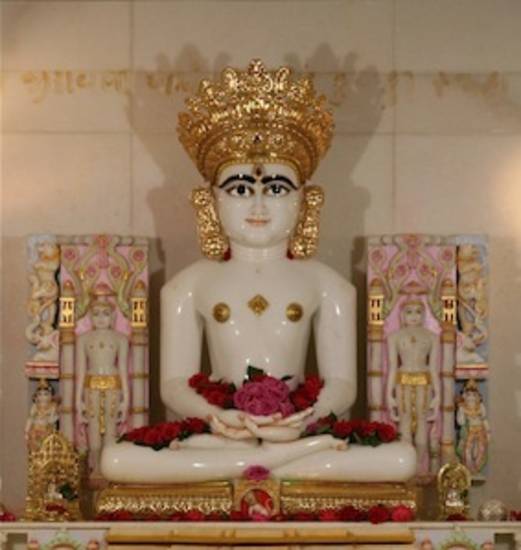
Māhavīra decorated
Image by Ravin Mehta © Ravin Mehta
From the Śvetāmbara perspective, Mahāvīra’s original teaching was ‘open’ – an idea that the Prakrit word pavayaṇa applied to it in some early scriptures might convey. This term implied the use of Prakrit instead of Sanskrit, which was associated with the restricted elite of the brahmins.
Therefore the Āgamas are written in Ardhamāgadhī Prakrit and another form of Prakrit known as Jaina Māhārāṣṭrī. The former is associated with the region of eastern India when Mahāvīra preached and the latter with western India. Somebody who understands one language can also understand the other because the differences are grammatical. The degree of blend depends on the texts. Earlier texts tend to have more Ardhamāgadhī.
From the 14th century onwards, regional languages tended to become an important medium of teaching and commenting. This did not mean that Prakrit and Sanskrit had become obsolete. Often corresponding to various levels of education, different languages were used depending on the context. Among Śvetāmbaras, this language was mainly Old Gujarati, used for the commentaries known as bālāvabodhas and ṭabos for instance. These range from extensive and in-depth explanations to word-to-word paraphrases, often equivalent to translations.
Commentaries
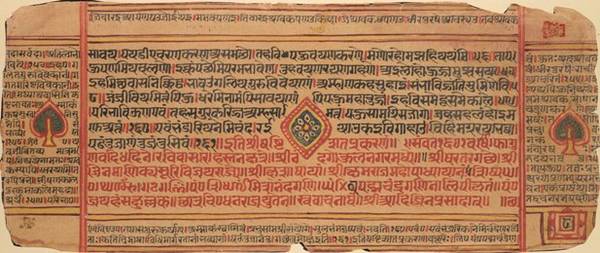
Pañca-pāṭha style of manuscript commentary
Image by British Library © The British Library Board
The sūtras would have been ‘somnolent’ (Dundas 1996), had they not been kept alive by constant explanations, elaborations and discussions from the start. Commentaries take different forms and use various languages. Particular forms and languages tend to be associated with certain periods of scholarly activity.
The early phase of commentaries on the Śvetāmbara canon uses Jaina Māhārāṣṭrī Prakrit. These commentaries are:
- the verse niryuktis and bhāṣyas composed during the first centuries CE
- the prose cūrṇis written over the 6th to 7th centuries
These are technical kinds of commentaries that apply scholastic methods of analysis to understand words and concepts. Niryuktis, especially, are highly technical and often go further than their starting text. Not all texts have given birth to such commentaries. Not all such commentaries have identified authors.
Nevertheless, prominent authors include Bhadrabāhu and Jinabhadragaṇi. The former is sometimes called ‘Bhadrabāhu II’ (for example, Wiley 2004: 52), because he is likely to be a different person from the earlier writer credited with the Kalpa-sūtra. He is said to be the author of ten niryuktis. The latter monk is famous as the author of bhāṣyas.
Taking place from the 8th century onwards, the next phase of commentarial activity uses Sanskrit for ṭīkās, vṛttis and avacūrṇis. These terms cover a wide range of commentaries, which are often hard to distinguish, as they vary from simple paraphrases to elaborate discussions. Some Jain monks have specialised in commentary writing and stand out as figures of high calibre in the tradition. Perhaps the most eminent examples are:
- Haribhadra-sūri, active in the 8th century
- Abhayadeva-sūri, writing in the 11th century, who commented on nine Aṅgas
- Malayagiri, who wrote in the 12th century.
In the later phase, from the 14th century onwards, the language of the Śvetāmbara commentaries is mainly Old Gujarati. The bālāvabodhas and ṭabos range from extensive and in-depth explanations to word-to-word paraphrases, often equivalent to translations.
Studying and teaching the Āgamas
Śvetāmbaras have displayed assorted attitudes towards their holy texts and the ways to use them. Scholar monks have used the scriptures to support or disprove intellectual and religious arguments down the centuries, which often have a sectarian dimension. Although knowledge of the teachings is a basic part of being a practising Jain, access to the teachings in written form has often been indirect for many Jains. This is again an issue of difference among the sects. Similarly, printing and editing the holy writings has been a controversial matter.
Since the medieval period, there is a great deal of evidence demonstrating how the scriptures are used in intellectual debates and controversies among learned mendicants (Granoff 1993, Dundas 2007, Balbir 2009 and others). An example of such an issue is that of image worship. The Mūrti-pūjak Śvetāmbaras practise it while the Sthānaka-vāsin and Terāpanthins reject it. The scholar monks often quote certain sections in particular works, sometimes giving the page number of the particular manuscript of the text they have used. Favoured since the 17th century, a question-and-answer format including scriptural quotations is a common method of presenting arguments and objections. These texts – praśnottaras or bols – are popular today as pedagogical tools.
Sectarian attitudes among both laity and mendicants vary regarding open access to all scriptures.
At the beginning of the 20th century, several monks complained that they could only access canonical writings through the mediation of commentaries in modern languages. They could not read the texts in the original language. This situation still applies today with variations depending on monastic orders and their attitudes towards religious education.
Nuns of the Śvetāmbara Tapā-gaccha sect are not allowed to read the Cheda-sūtras. These texts deal with monastic discipline in great detail. Lay people are generally not supposed to read them either.
Mendicants of the Śvetāmbara Mūrti-pūjak orders study the Āgamas in a steady staged manner (Cort 2001). A junior monk starts with the basic texts – the Mūla-sūtras – and in time moves on to read more technical texts as he becomes more senior. This progression is codified in books dealing with the monastic way of life.
Both mendicant and lay Jains usually believe that the laity should read the Āgamas in their narrowest interpretation together with or under mendicant supervision. But they can read alone stories, hymns or digests that are specially produced for lay people and can learn about the Āgamas from monastic sermons. Thus there are ‘practical canons’ (Cort 2001, Dundas 2002: 63) for various purposes and people, which may evolve in the course of time.
Printing scriptures
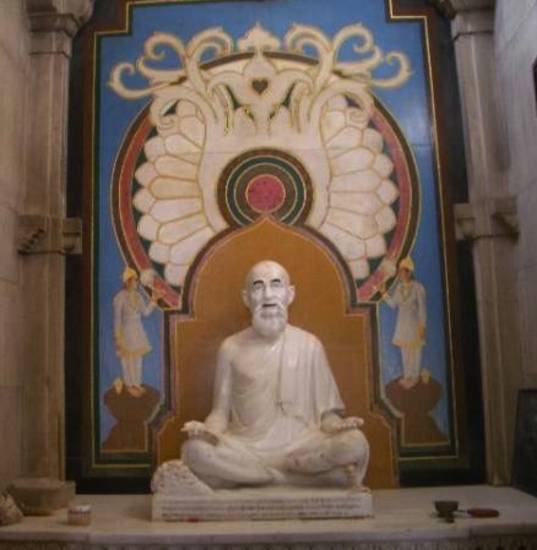
Image of Ānandasāgara-sūri
Image by Nalini Balbir © Nalini Balbir
Jains have often been resistant to the idea of printing the holy writings. One reason is because printing is a mechanical process and may therefore involve harm. Another one is the quasi-magical qualities attributed to scriptures.
After opposition from some monks and lay people, the first printed edition of the Śvetāmbara Āgamas was published in 1874.
Maintaining knowledge of the original Āgamas among Śvetāmbara Jain mendicants has been an issue in the 20th century and is still so today. The monk Ānandasāgara-sūri (1875–1950) was one of the driving forces in reviving this declining knowledge. He founded the Āgamodaya Samiti publishing house, which specialises in publishing the sūtras and their commentaries in their original languages.
Editing scriptures
Śvetāmbara Āgamas have been passed on through palm-leaf and paper manuscripts in western India since the 12th century without break. The material available is thus overwhelmingly large. The texts are all separate, with no single manuscript collecting them together. They are copied either individually or in small sets. Published editions of the holy writings tend to use different manuscripts for the various texts.
There is no central religious authority among Jains so a single edition serving as the final, authorised word is impossible and does not seem to be an issue. Rather, numerous editions of the scriptures have been published since the end of the 19th century, of varying types and standards. This is the case today.
The first critical editions to use palm-leaf manuscripts and provide critical apparatus such as a glossary or references were published in 1968. These efforts were led by the prominent scholar monks:
Muni Puṇyavijaya and lay Jain scholars began publishing the Jaina-Āgama-Series from the Mahāvīra Jain Vidyālay in Bombay. At the same time Ācārya Tulsi and Ācārya Mahāprajña published the Ladnun edition. These editions differ because the editors hold varying opinions on how commentaries should be used in textual history.
Reading
- Jaina Studies: Their Present State and Future Tasks
Ludwig Alsdorf - translated by Bal Patil
edited by Willem Bollée
Hindi Granth Karyalay; Mumbai, Maharashtra, India; 2006
- ‘Samayasundara’s Sāmācārī-śataka and Jain Sectarian Divisions in the Seventeenth Century’
Nalini Balbir - Essays in Jaina Philosophy and Religion
edited by Piotr Balcerowicz
Lala Sundara Jain Research series; volume 20
Motilal Banarsidass; Delhi, India; 2003
- ‘Autobiographies of Jain Monks and Nuns in the 20th Century: A Preliminary Essay’
Nalini Balbir - Jaina Studies
edited by Colette Caillat and Nalini Balbir
Papers of the XIIth World Sanskrit Conference series; series editor Petteri Koskikallio and Asko Parpola; volume 9
Motilal Banarsidass; Delhi, India; 2008
- ‘Les lecteurs jaina śvetāmbara face à leur canon’
Nalini Balbir - Ecrire et transmettre en Inde classique
edited by Gérard Colas and Gerdi Gerschheimer
Études thématiques series; volume 23
École Française d’Extrême Orient; Paris; 2009
- ‘Is a Manuscript an Object or a Living Being?: Jain Views on the Life and Use of Sacred Texts’
Nalini Balbir - The Death of Sacred Texts: Ritual Disposal and Renovation of Texts in World Religions
edited by Kristina Myrvold
Ashgate; Aldershot, Hampshire UK; 2010
- ‘On the role and meaning of the Śvetāmbara canon in the history of Jainism’
Nalini Balbir - Studies in Jaina History and Culture: Jaina Law
edited by Peter Flügel
Routledge Advances in Jaina Studies series; volume 4
Routledge Curzon Press; London, UK; 2013 – forthcoming
- ‘Old texts, new images: Illustrating the Śvetāmbara Jain Āgamas today’
Nalini Balbir - In the Shadow of the Golden Age
edited by Julia A. B. Hegewald
University of Bonn Press; Bonn, North Rhine-Westphalia, Germany; 2012
- ‘The Recent Critical Editions of the Jain Āgama’
Colette Caillat - Zeitschrift der Deutschen Morgenländischen Gesellschaft
volume 21: supplement 5
F. Steiner; 1980
- ‘Notes sur les variantes dans la tradition du Dasaveyāliya-sutta’
Colette Caillat - Indologica Taurinensia
volume 8–9
International Association of Sanskrit Studies; 1980–81
- In Search of the Original Ardhamāgadhī
N. M. Kansara - translated by K. R. Chandra
Prākrt̥a Grantha Pariṣad series; volume 35
D. M. Prakrit Text Society; Ahmedabad, Gujarat, India; 2001
- ‘The Intellectual Formation of a Jain Monk: A Śvetāmbara Monastic Curriculum’
John E. Cort - Journal of Indian Philosophy
volume 29
2001
- ‘Śvetāmbar Mūrtipūjak Jain Scripture in a Performative Context’
John E. Cort - Texts in Context: Traditional Hermeneutics in South Asia
edited by Jeffrey R. Timm
State University of New York Press; Albany, New York, USA; 1992
- ‘Somnolent Sūtras: Scriptural Commentary in Śvetāmbara Jainism’
Paul Dundas - Journal of Indian Philosophy
volume 25
1996
- The Jains
Paul Dundas - Library of Religious Beliefs and Practices series; series editor John Hinnels and Ninian Smart; volume 14
Routledge Curzon Press; London, UK; 2002
- History, Scripture and Controversy in a Medieval Jain Sect
Paul Dundas - Routledge Advances in Jaina Studies series; series editor Peter Flügel; volume 2
Routledge Curzon Press; London, UK; 2007
- ‘Protestantische und Post-Protestantische Jaina-Reformbewegungen: zur Geschichte und Organisation der Sthānakavāsi II’
Peter Flügel - Berliner Indologische Studien
volume 15–17
Berlin, Germany; 2003
- Scripture and Community: Collected Essays on the Jains
Kendall W. Folkert - edited by John E. Cort
Studies in World Religions series; volume 6
Center for the Study of World Religions, Harvard University & Scholars Press; Atlanta, Georgia, USA; 1993
- ‘Going by the Book: The Role of Written Texts in Medieval Jain Sectarian Conflicts’
Phyllis Granoff - Jain Studies in Honour of Jozef Deleu
edited by Rudy Smet and Kenji Watanabe
Hon-no-Tomosha; Tokyo, Japan; 1993
- The Lives of the Jain Elders
Hemacandra - translated and edited by R. C. C. Fynes
Oxford World’s Classics series
Oxford University Press; Oxford, UK and New York, USA; 1998
- 'The Kalpa Sûtra of Bhadrabâhu'
Bhadrabāhu - translated and edited by Hermann Jacobi
Abhandlungen für die Kunde des Morgenlandes
Deutschen Morgenländischen Gesellschaft series; series editor Otto Loth; volume VII: 1
F. A. Brockhaus; Leipzig, Saxony, Germany; 1879
- The Jaina Path of Purification
Padmanabh S. Jaini - University of California Press; Berkeley, California USA; 1979
- ‘Hemaraja Pande’s Caurāsī Bol’
Padmanabh S. Jaini - Jambū-jyoti: Munivara Jambūvijaya Festschrift
edited by Madhusudan A. Dhaky and J. B. Shah
Shresthi Kasturbhai Lalbhai Smarak Nidhi series; volume 7
Sharadaben Chimanbhai Educational Research Centre; Ahmedabad, Gujarat, India; 2004
- Āgama aura Tripiṭaka: A Comparative Study of Lord Mahavira and Lord Buddha
Acharya Nagaraj - Language and Literature series; volume II
Concept Publishing Company; New Delhi, India; 2003
- The Doctrine of the Jainas: Described after the Old Sources
Walther Schubring - translated by Wolfgang Bühlen
edited by Satya Ranjan Banerjee
Lala Sunder Lal Jain Research series; volume 15
Motilal Banarsidass; New Delhi, India; 2000
- ‘The Dating of the Jaina Councils: Do Scholarly Presentations Reflect the Traditional Sources?’
Royce Wiles - Studies in Jaina History and Culture: Disputes and Dialogues
edited by Peter Flügel
Routledge Advances in Jaina Studies series; volume 1
Routledge Curzon Press; London, UK; 2006
- The “Śvetāmbara Canon.” A Descriptive Listing of Text Editions, Commentaries, Studies and Indexes: Based on Editions held in the Library of the Australian National University
Royce Wiles - unpublished; Canberra, Australia; 1997
- ‘The First Collected Edition of Śvetāmbara Jain Canonical Texts’
Royce Wiles - Studia Indologica: Professor Satya Ranjan Banerjee Felicitation Volume
edited by Jagat Ram Bhattacharyya
Eastern Book Linkers; Delhi, India; 2007
- Historical Dictionary of Jainism
Kristi L. Wiley - Historical Dictionaries of Religions, Philosophies, and Movements series; series editor Jon Woronoff; volume 53
Scarecrow Press; Maryland, USA; 2004
Links
- Namaskāra-mantra and Bhaktāmara-stotra with yantras – part one
-
This YouTube slideshow features a recording of the Namaskāra-mantra followed by the Bhaktāmara-stotra, a famous Sanskrit hymn of praise to the first Jina, Ṛṣabha.;
Also known as the Navkār-mantra or Namokār-mantra, the Namaskāra-mantra is a very old mantra in Prakrit. It can be sung to different tunes and is chanted daily to honour the 'five types of beings worthy of worship' or Supreme Beings':
Bhaktāmara-stotra means Devoted Gods. This title comes from the first verse, which describes how all the gods offer homage to Ṛṣabha. The slideshow includes colour-tinted yantras and mantras to help listeners meditate.
This is the first of four parts of the Śvetāmbara hymn, which has 44 verses. This part contains stanzas 1 to 12.
http://www.youtube.com/watch?v=ZzJtiikKnh4
This YouTube slideshow features a recording of the Bhaktāmara-stotra, a famous Sanskrit hymn of praise to the first Jina, Ṛṣabha. The title Devoted Gods comes from the first verse, which describes how all the gods offer homage to Ṛṣabha. The slideshow includes colour-tinted yantras and mantras to help listeners meditate.
This is the first of four parts of the 44-verse Śvetāmbara hymn, covering stanzas 01 to 12
https://www.youtube.com/watch?v=ZzJtiikKnh4&list=PLE8A9751AC19A4277
- Bhaktāmara-stotra with yantras – part two
-
This YouTube slideshow features a recording of the Bhaktāmara-stotra, a famous Sanskrit hymn of praise to the first Jina, Ṛṣabha. The title Devoted Gods comes from the first verse, which describes how all the gods offer homage to Ṛṣabha. The slideshow includes colour-tinted yantras and mantras to help listeners meditate.
This is the second of four parts of the 44-verse Śvetāmbara hymn, covering stanzas 13 to 25.
- Bhaktāmara-stotra with yantras – part three
-
This YouTube slideshow features a recording of the Bhaktāmara-stotra, a famous Sanskrit hymn of praise to the first Jina, Ṛṣabha. The title Devoted Gods comes from the first verse, which describes how all the gods offer homage to Ṛṣabha. The slideshow includes colour-tinted yantras and mantras to help listeners meditate. The yantras in this part begin with the svastika, ancient Asian symbol of well-being and good fortune.
This is the third of four parts of the 44-verse Śvetāmbara hymn, covering stanzas 26 to 38.
- Bhaktāmara-stotra with yantras – part four
-
This YouTube slideshow features a recording of the Bhaktāmara-stotra, a famous Sanskrit hymn of praise to the first Jina, Ṛṣabha. The title Devoted Gods comes from the first verse, which describes how all the gods offer homage to Ṛṣabha. The slideshow includes colour-tinted yantras and mantras to help listeners meditate.
This is the last of four parts of the 44-verse Śvetāmbara hymn, covering stanzas 39 to 44.
- Bhogilal Leherchand Institute of Indology
-
The Bhogilal Leherchand Institute of Indology in New Delhi focuses on scholarly research into Śvetāmbara Jainism. With a library of manuscripts for research, it organises academic seminars and publishes scholarly books.
- Lalbhai Dalpatbhai Institute of Indology and Museum
-
Based in Ahmedabad, Gujarat, the Lalbhai Dalpatbhai Institute of Indology is a national centre affiliated to the National Mission for Manuscripts. With a library of manuscripts, it has a specific section for manuscript preservation and cataloguing. In addition to holding seminars for researchers into Śvetāmbara Jainism, the L. D. Institute publishes books and the Sambodhi journal in English, Hindi and Gujarati. The L. D. Museum, on the same site, holds an important collection of Jain artefacts – statues, manuscripts, the N. C. Mehta Collection of paintings and a gallery of monastic equipment that belonged to Muni Puṇyavijaya.
- Mahavir Aradhana Kendra – institute
-
Based around the pilgrimage site of Mahaviralaya – a temple dedicated to Mahāvīra, the last Jina – Mahavir Aradhana Kendra is a manuscript library and research institute, which publishes academic books, chiefly on Śvetāmbara Jainism. There is also a museum that includes the monastic equipment used by Gacchādhipati Ācārya Śrī Kailāsaāgara-sūrīśvara Mahārāj.
- Parshvanath Vidyashram Research Institute
-
The Parshvanath Vidyashram Research Institute focuses on research into Śvetāmbara Jainism. Based in Varanasi, in Uttar Pradesh, it has a manuscript library and publishes books and the Śramaṇ journal in Hindi and English.
- Two Śvetāmbara Terāpanthin samaṇī nuns
-
This YouTube video dating from 2009 shows two Śvetāmbara Terāpanthin samaṇīs tallking about their religious background and beliefs. They hold folded cloths in front of their mouths while they speak. Normally Śvetāmbara Terāpanthin monks and nuns wear a mouthcloth – muṃhpatti – permanently over their mouths, hanging from strings over the ears. Samaṇīs have important roles in teaching the Jain diaspora.
- +
- aAbhavya
- aAbhinandana
- aAbhiṣeka
- aĀcāra
- aĀcārāṅga-sūtra
- aĀcārya
- aAchalbhrata
- aAḍhāī-dvīpa
- aAdharma
- aAdho-loka
- aAdhyayana
- aAdvaita Vedānta
- aĀgama
- aAghātīya
- aAghātīya-karman
- aAgnibhuti
- aAgra
- aĀhāra
- aAhiṃsā
- aAhimsa Day
- aAjita
- aAjīva
- aAkampit
- aĀkāśa
- aAkbar the Great
- aAkṣaya-tṛtīyā
- aAlauddin Khalji
- aAlbert Einstein
- aAllah
- aAlms
- aĀlocanā
- aAloka-ākāśa
- aAmāri
- aAmbikā or Kūṣmāṇḍinī
- aAnagāra
- aAnanta
- aAnarthadaṇḍa
- aAnaśana
- aAnekānta-vāda
- aAṅga
- aAniconism
- aAnojjā
- aAntarāla
- aAntarāya-karma
- aAṇu
- aAṇu-vrata
- aAnukampā
- aAnuprekṣā
- aAnusvāra
- aApabhraṃśa
- aAparigraha
- aAra
- aĀrambha
- aĀrambhaja
- aĀratī
- aArdhamāgadhī Prākrit
- aArhaṃ
- aArhat
- aArśana-āvaraṇīya-karma
- aĀrta-dhyāna
- aĀryikā
- aĀryikā Jñānamati
- aĀśātanā
- aĀścarya
- aAscetic
- aAsceticism
- aAshram
- aAspiration
- aĀsrava
- aAṣṭa-maṅgala
- aAṣṭāpada
- aAstikāya
- aAstrolabe
- aAsura
- aAtheism
- aAticāra
- aAtiśayakṣetra
- aAtithisaṃvibhāgavrata
- aĀtma-vāda
- aĀtman
- aAuṃ
- aAurangzeb
- aAuspicious
- aAusterity
- aAvadhāna
- aAvadhi-jñāna
- aĀvaraṇī-yakarman
- aAvasarpiṇī
- aAvatāra
- aAvidyā
- aAxiom
- aĀyāga-paṭa
- aĀyambil
- aĀyu-karma
- aĀyurveda
- bBabur
- bBāhubali
- bBaladeva
- bBālāvabodha
- bBandha
- bBasadi
- bBazaar
- bBhadrankarvijay
- bBhagavant
- bBhaktāmara-stotra
- bBhakti
- bBhale
- bBharata
- bBhāṣā
- bBhāṣya
- bBhaṭṭāraka
- bBhāva
- bBhāva-pūjā
- bBhāvanā
- bBhavana-vāsin
- bBhavya
- bBhavyatva
- bBhaya
- bBhoga-bhūmi
- bBhogopabhoga
- bBodhi
- bBollywood
- bBrahmā
- bBrahma-deva
- bBrahmacārī
- bBrāhmaṇa
- bBraj Bhāṣā
- bBright fortnight
- bBritish Raj
- bBuddha
- bBuddhi-sagar
- bBuddhism
- bBuddhist
- cCaitya
- cCaityavāsin
- cCakravartin
- cCakreśvarī
- cCāmara
- cCandanā
- cCandragupta
- cCandraprabha
- cCanon
- cCāritra
- cCāritramohanīya-karman
- cCarũrī
- cCaste
- cCaturvidha-saṅgha
- cCaturviṃśati-stava
- cCāturyāma
- cCE
- cCelibacy
- cCha
- cChadmastha
- cChastity
- cCheda-sūtra
- cChristian
- cChristianity
- cClergy
- cCloning
- cColophon
- cCommentary
- cConch
- cConfession
- cCongregation
- cConsecration
- cCosmology
- cCremation
- cCrore
- cCult
- cCūrṇi
- dDādā-guru
- dDalit
- dDāna
- dDaṇḍa
- dDark fortnight
- dDarśana
- dDarśanamohanī-yakarman
- dDaśa-lakṣaṇa-parvan
- dDeity
- dDelhi Sultanate
- dDerāsar
- dDeśāvakāśika-vrata
- dDetachment
- dDevanāgarī
- dDevānandā
- dDevarddhi-gani
- dDevotee
- dDhamal
- dDhanuṣ
- dDhāra
- dDharma
- dDharma-dhyāna
- dDharma-sāgara
- dDharmastikaya
- dDhātakīkhaṇḍa
- dDholak
- dDhyāna
- dDiaspora
- dDig-vrata
- dDigambara
- dDīkṣā
- dDisciple
- dDīvālī
- dDivya-dhvani
- dDNA
- dDoctrine
- dDogma
- dDonor
- dDoṣa
- dDravya
- dDravya-pūjā
- dDrone
- dDuṣamā
- dDuṣamā-duṣamā
- dDuṣamā-suṣamā
- dDveṣa
- dDvīpa
- eEast India Company
- eEightfold Path
- eEkānta-vāda
- eEkendriya
- eElder
- eElders
- eEschatology
- eEtc up to
- fFarmān
- fFast
- fFatehpur Sikri
- fFestival
- fFestschrift
- fFiruz Shah
- fFly-Whisks
- fFolio
- fFour Noble Truths
- gGaccha
- gGaṇa
- gGaṇadhara
- gGanadharavada
- gGaṇeśa
- gGaṇin
- gGarba
- gGarbha
- gGarbha-gṛha
- gGaruḍa
- gGati
- gGene
- gGenomics
- gGhātī-yakarman
- gGhātīya
- gGhaznavid
- gGhiyasuddin Tughlaq
- gGhurid
- gGloss
- gGotra-karma
- gGujarāt
- gGujarati
- gGuṇa
- gGuṇa-sthāna
- gGuṇa-vrata
- gGupti
- gGuru
- gGuruṇī
- hHagiography
- hHajj
- hHaṃsa
- hHaribhadra
- hHariṇaigameṣin
- hHasta
- hHeresy
- hHiṃsā
- hHindi
- hHindu
- hHinduism
- hHīravijaya
- hHoroscope
- hHrīṃ
- hHumayun
- hHymn
- iIconoclasm
- iIconography
- iIdol
- iIndian Independence
- iIndology
- iIndra
- iIndrabhūti Gautama
- iIndriya
- iInitiation
- iIntercession
- iInvocation
- iIQ
- iIslam
- iIslamicate
- iIṣṭadevatā
- iĪśvara
- jJagat
- jJahangir
- jJain
- jJaina Devanāgarī
- jJaina Śaurasenī
- jJaina-dharma
- jJainaśāsana
- jJainness
- jJaisalmer
- jJamāli
- jJambū-dvīpa
- jJames Burgess
- jJanma
- jJanma-kalyāṇa
- jJarā
- jJāti
- jJina
- jJina-āgama
- jJina-bhavana
- jJina-bimba
- jJina-mātā
- jJinacandra-sūri
- jJinadatta
- jJinaprabha
- jJīva
- jJñāna
- jJñāna-āvaraṇīya-karma
- jJñāna-āvarṇiya
- jJñānsundar
- jJyotiṣka
- kKāla
- kKālakācārya-kathā
- kKālidāsa
- kKalpa-sūtra
- kKalpa-vṛkṣa
- kKalyāṇaka
- kKalyanvijay
- kKamaṇḍalu
- kKamaṭha
- kKarma
- kKarma-bhūmi
- kKarma-grantha
- kKarma-prakṛti
- kKarma-vāda
- kKarmon
- kKarnataka
- kKaṣāya
- kKathā
- kKāvya
- kKāya
- kKāyotsarga
- kKeśa-loca
- kKetu
- kKevala-jñāna
- kKevalin
- kKhalji
- kKharatara-gaccha
- kKnowledge
- kKriyā
- kKriyā-vāda
- kKṛṣṇa
- kKṣamā-śramaṇa
- kKṣapakaśreṇi
- kKṣatriya
- kKṣullaka
- kKulakara
- kKundakunda
- kKunthu
- lLabdhi
- lLaity
- lLakh
- lLāñchana
- lLands of Action
- lLaukāntika
- lLavaṇa-samudra
- lLeśyā
- lLiṅga
- lLinguistics
- lLoka
- lLoka-ākāśa
- lLoka-puruṣa
- lLoka-vāda
- lLotus
- lLotus lake
- mMadhya-loka
- mMahā-videha
- mMahā-vrata
- mMahābhārata
- mMahāmastakābhiṣeka
- mMāhārāṣṭra
- mMāhārāṣṭrī Prākrit
- mMahattarā Yākinī
- mMahāvīr Jayantī
- mMahāvīra
- mMakāra
- mMakkhali Gośāla
- mMalli
- mMāna-stambha
- mManaḥ-paryāya-jñāna
- mMaṇḍala
- mMaṇḍapa
- mMandit
- mMaṅgala
- mMantra
- mMantras
- mManuṣya-loka
- mMarāṭhī
- mMārgaṇā
- mMartyr
- mMarudevī
- mMaṭha
- mMati-jñāna
- mMauryaputra
- mMecca
- mMendicant lineage
- mMetarya
- mMiracle
- mMithyādṛṣṭi
- mMohandas Gandhi
- mMohanīya-karma
- mMokṣa
- mMonastic order
- mMonasticism
- mMonk
- mMonotheism
- mMosque
- mMount Meru
- mMount Sammeta
- mMṛgāvatī
- mMughal
- mMuhammad
- mMuhammad bin Tughlaq
- mMuhpattī
- mMūla-sūtra
- mMūlaguṇa
- mMumbaī
- mMuni
- mMunisuvrata
- mMurad Bakhsh
- mMūrti-pūjaka
- mMuslim
- mMysticism
- nNābhi
- nNāga-kal
- nNāgapurīya Tapā-gaccha
- nNāgarī
- nNāma-karma
- nNamaskāra-mantra
- nNami
- nNandīśvara-dvīpa
- nNandivardhana
- nNandyāvarta
- nNāraka
- nNāraki
- nNasalisation
- nNātha
- nNavrātrī
- nNaya-vāda
- nNemi
- nNidāna
- nniggaṃthāṇa vā 2
- nniggaṃtho vā 2
- nNigoda
- nNihnava
- nNikṣepa
- nNirgrantha
- nNirjarā
- nNirvāṇa
- nNiryukti
- nNiṣidhi
- nNitya
- nNiyati
- nNo-kaṣāya
- nNudity
- nNun
- oOcean of milk
- oOmniscience
- oOrdination
- ppa°
- pPadmaprabha
- pPadmāsana
- pPadmāvatī
- pPādukā
- pPalanquin
- pPalette
- pPañca-muṣṭi
- pPāṇḍava
- pPaṇḍit
- pPandit Dalsukh D. Malvania
- pPandit Sukhlalji
- pPāṇipātra
- pPāpa
- pParamātman
- pParameṣṭhin
- pPāraṇā
- pParigraha
- pPariṇāma
- pParīṣaha
- pParokṣa
- pPārśva
- pPārśvanātha
- pParyāya
- pParyuṣaṇ
- pPaṭa
- pPatan
- pPātra
- pPenance
- pPersian
- pPhala
- pPhilology
- pPicchikā
- pPilgrimage
- pPīr
- pPolymath
- pPoṣadha
- pPossession
- pPothī
- pPrabhas
- pPradakṣiṇā
- pPradeśa
- pPrākāra
- pPrakīrṇaka-sūtra
- pPrākrit
- pPramāda
- pPramukhā
- pPrati-vāsudeva
- pPratikramaṇa
- pPratimā
- pPratiṣṭhā
- pPratyākhyāna
- pPratyakṣa
- pPravacana
- pPrāyaścitta
- pPrayer
- pPre-modern
- pPreach
- pPredestination
- pProtestant
- pProvenance
- pPudgala
- pPūjā
- pPujārī
- pPukharavara-dvīpa
- pPuṇya
- pPūrva
- pPuṣkara-dvīpa
- pPuṣpadanta
- pPyre
- qQur’an
- rRāga
- rRāhu
- rRainy season
- rRajasthan
- rRajasthani
- rRājimatī
- rRajoharaṇa
- rRajput
- rRāma
- rRāmāyaṇa
- rRangoli
- rRās-garbā
- rRasa
- rRathanemi
- rRatna-traya
- rRātri-bhojana
- rRaudra-dhyāna
- rRecto
- rRelic
- rRenunciation
- rRetroflex
- rRevatī
- %Ṛg-veda
- rRite
- rRosary
- %Ṛṣabha
- %Ṛṣabhanātha
- rRupee
- sSaciyā Mātā
- sSādhu
- sSādhvī
- sSāgāra
- sSaint
- sŚaivaism
- sŚaka-saṃvat
- sSallekhanā
- sŚalya
- sSamacatuṣṭha
- sSamādhimaraṇa
- sSamaṇi
- sSāmarambha
- sSamavasaraṇa
- sSāmāyika
- sSaṃbhava
- sSamiti
- sSaṃjñā
- sSaṃkalpaja
- sSaṃsāra
- sSamudghāta
- sSaṃvara
- sSaṃvega
- sSamyak-cāritra
- sSamyak-darśana
- sSamyak-jñāna
- sSamyaktva
- sSaṃyama
- sSanctuary
- sSandalwood
- sSaṇgha
- sSanskrit
- sSant
- sŚānti
- sSapta-bhaṅgi-naya
- sSārambha
- sSarasvatī
- sSarvajña
- sSāsan-devi
- sŚāsana-devatā
- sŚāstra
- %Ṣaṭ-jīvanikāya
- sSatī
- sSatīmātā
- sSatya
- sSchism
- sScribe
- sScripture
- sSect
- sSecularism
- sŚenāī
- sSermon
- sŚeṣavatī
- sSevā
- sSeven fields of donation
- sShah Jahan
- sShantidas Jhaveri
- sShrine
- sSiddha
- sSiddha-śilā
- sSiddhacakra or Navadevatā
- sSiddhānta
- sSiddhārtha
- sSiddhi
- sSikh
- sSikhism
- sŚikṣā-vrata
- sŚīla
- sSin
- sSindh
- sŚītala
- sŚiva
- sSkandha
- sSomanatha
- sŚraddhā
- sŚramaṇa
- sŚrāvaka
- sŚrāvakācāra
- sŚrāvikā
- sŚreyāṃsa
- sŚrī
- sŚrīvatsa
- sŚruta-jñāna
- sŚruta-pañcamī
- sSthānaka-vāsin
- sSthāpanācārya
- sSthāvara
- sSthavira
- sSthiti
- sStrīmukti
- sStūpa
- sSubcontinent
- sSudarshana
- sŚuddhi
- sSudharma
- sŚūdra
- sSufism
- sSukha
- sŚukla-dhyāna
- sSulasā
- sSultan
- sSumati
- sSundarśrī
- sSupārśva
- sSūri
- sSuṣamā
- sSuṣamā-duṣamā
- sSuṣamā-suṣamā
- sSūtra
- sSuyam me ausam! Tenam bhagavaya evamakkhayam
- sSvādhyāya
- sSvāhā
- sSvastika
- sŚvetāmbara
- sŚvetāmbara Terāpanthin
- sŚvetāmbaras
- sSwan
- sSyād-vāda
- tTabla
- tTantra
- tTapā-gaccha
- tTapas
- tTāraṇ Svāmī Panth
- tTattva
- tTattvārtha-sūtra
- tTemple
- tTemple-city
- tThe Enlightenment
- tTheology
- tThree worlds
- %Ṭīkā
- tTilaka
- tTīrtha
- tTīrthaṃkaranāma-karman
- tTīrthankara
- tTransliteration
- tTrasa
- tTrasa-nāḍī
- tTriśalā
- tTriṣaṣṭi-śalākā-puruṣa-caritra
- tTti bemi
- tTughlaq
- tTunk
- uUdumbara
- uUniversal History
- uUpādhyāya
- uUpāṅga
- uUpaniṣads
- uUpāsaka
- uUpasarga
- uUpāśraya
- uŪrdhva-loka
- uUtsarpiṇī
- uUttarādhyayana-sūtra
- vVāhana
- vVaimānika
- vVairāgya
- vVaiṣṇava
- vVaiśramaṇa
- vVaiśya
- vValabhī
- vVanaspatikāya
- vVandana
- vVaṇik
- vVarṇa
- vVāsudeva
- vVāsupūjya
- vVayubhūti
- vVeda
- vVedanīya-karma
- vVegetarianism
- vVehicle
- vVernacular
- vVerso
- vVidyā
- vVidyā-devī
- vVihāra
- vVijñapti-patra
- vVikrama-saṃvat
- vVikṛti
- vVimala
- vVinaya
- vVipāka
- vVirji Vora
- vVirodhaja
- vVīrya
- vVisarga
- vViṣṇu
- vVītarāga
- vVizier
- vVotive
- vVow
- vVrata
- vVS
- vVyakta
- vVyantara
- vVyasana
- yYakṣa
- yYakṣī
- yYantra
- yYaśoda
- yYaśovijaya
- yYati
- yYātrā
- yYoga
- yYoginī
- yYojana


